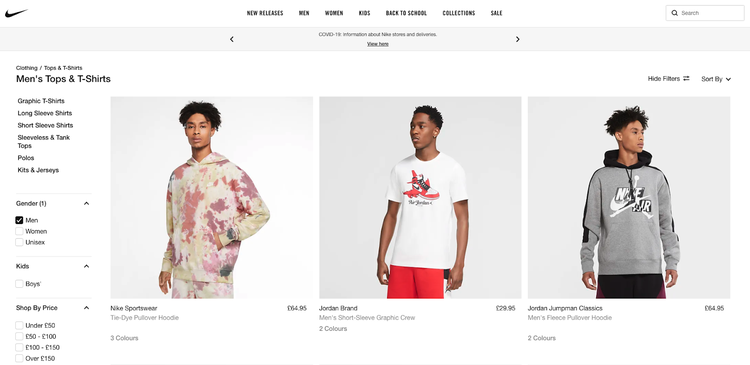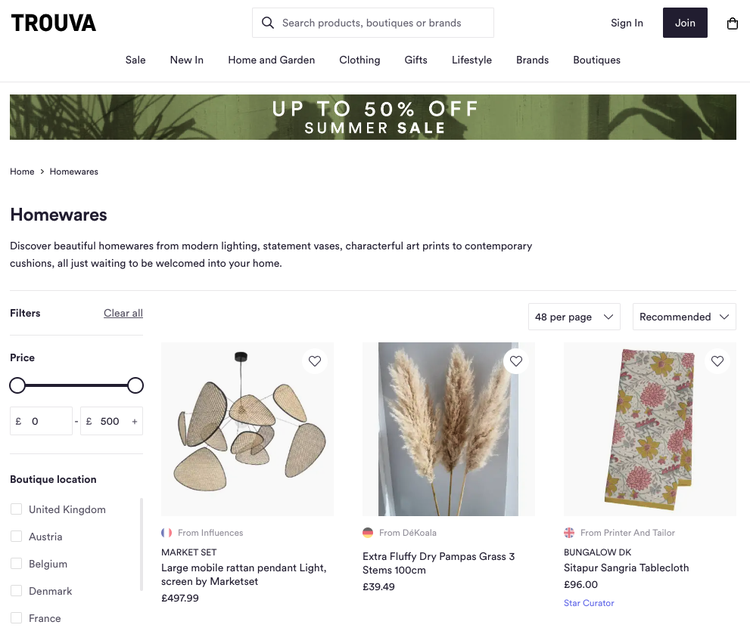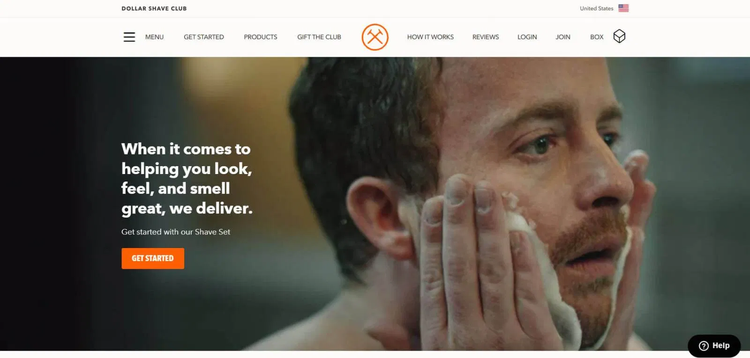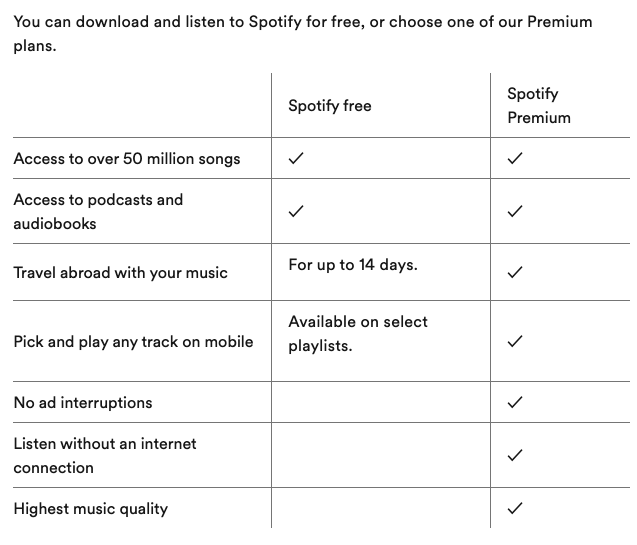What is a business model?
There is general agreement that a business model describes how a company makes money, but it's more than that.
A business model details how a company creates and captures value. It is a plan for generating revenue, based on the products or services it will sell and how it aims to sell them. It also considers the current customers’ needs and wants, along with their future demands.
When considering how to start an online store, business models are an important consideration. The era of e-commerce is rife with opportunities, but it's competitive, too. Getting things right at the business model stage can make all the difference.
We can simplify this process significantly by identifying the four types of e-commerce business models.
The 4 types of e-commerce business models:
- Product
- Marketplace
- Subscription
- Freemium
Type 1: Product
The online business model for products is most similar to the traditional retail model in the offline world. A business sets up its online store using one of many e-commerce platforms and sells its wares to customers online.
The product business model is most often used by business-to-consumer (B2C) e-commerce companies, but can be equally successful in business-to-business (B2B) organizations.
We can see this model on show if we consider e-commerce categories such as fashion, electronics, or groceries.

The Image source: Author
Nike website works based on a product business model. Source: Nike.
In a traditional retail store, the customer can usually pick up the product and take it home, once they pay for it.
But in the e-commerce industry, there is a gap between order and delivery. This opens a window of opportunity for alternative approaches to order fulfillment.
The following are the most common paths to implement the product business model:
- Dropshipping: This is one of the newer e-commerce concepts and is a great way to get your store up and running. Rather than buying stock in bulk and storing it in a warehouse, you order products from the supplier only after you receive an order. You pay the supplier, it ships the item, and then your business handles customer service. Dropshipping is best for businesses with a low risk tolerance and limited capital to invest up-front.
- Print on-demand: Printing on-demand offers similar benefits to dropshipping but is naturally limited to a smaller set of products. Your customers can customize their products with their own designs, which are created and shipped once the order clears.

Selfie face masks are an example of the print on-demand fulfillment model. Image source: Author
- Wholesaling: The business agrees on a price with a supplier, securing a discount for buying in bulk. It must then store the products and ship them to customers, once online orders are received. This provides more control but comes with increased risk. In the e-commerce world, wholesaling is also common within the next business model on our list.
Type 2: Marketplace
E-commerce marketplaces are platforms where buyers and sellers can connect. They are flexible and cost-effective, as they require minimal setup resources from the marketplace owner.
For example, Amazon operates a marketplace for both B2C e-commerce and B2B e-commerce, offering pretty much every product under the sun. In spite of owning the platform, Amazon does not typically own or sell the products.
Sellers can create an account and access Amazon’s vast audience of consumers, bringing benefits to all parties. The seller can instantly reach new customers, customers can buy more products, and the Amazon platform becomes more appealing.
These network effects make marketplaces one of the most successful e-commerce strategies today.
It's challenging for new marketplaces to establish this initial audience. You need to attract both buyers and sellers, but how can you attract one without the other? This is known as the “chicken and egg problem,” fittingly enough.
One helpful approach is to focus on one area first, then expand to additional verticals once you've established the platform. Trouva, the independent boutique marketplace, has exemplified this strategy.

Trouva is a “vertical marketplace” that focuses on selling products from independent boutiques. Image source: Author
As a seller, you can open an account with the right marketplace and piggyback on its existing popularity. You will have to pay commission to the owner from your sales, and you may have less control over your brand identity and customer data.
Many e-commerce retailers will use the product and marketplace online business models, as their strengths are complementary.
Type 3: Subscription
The subscription business model has taken off recently. You can subscribe to all manner of products online, from coffee beans to gourmet dog food. You can also sign up to TV streaming, music, and software packages via subscriptions.
This business model offers convenience and peace of mind for the customer. Fees are paid weekly, monthly, or annually, so customers can set up recurring payments and access the service on their own terms.
One of the most effective e-commerce examples in this category is Dollar Shave Club, which upended the “razor and blades” business model with its e-commerce subscriptions.

Dollar Shave Club brought subscriptions to the razor industry to great effect. Image source: Author
Subscriptions are great for businesses, too. They provide recurring revenue at a relatively stable rate, allowing you to forecast and invest in the future.
It's important to ensure that a subscript model will also be beneficial for your customers. There is a sense of subscription fatigue now, with an overabundance of options to choose from. People have signed up to so many services that they approach new offers with caution.
Subscriptions also bring variable costs to the business, depending on the nature of the offering. Software subscriptions are often capped to a specific level of usage, which makes it easier to project future running costs.
Some “all-you-can-eat” subscriptions are dependent on a predicted level of use. Retailers that offer unlimited free shipping for a one-off fee are reliant on customers buying products above a certain price threshold, for example.
When shifting to a subscription business model, factor in multiple scenarios for customer churn and operating costs based on customer usage of the service. With these risks taken into account, this can be a highly beneficial business model.
Type 4: Freemium
Free + premium = freemium.
In this model, a product or service is provided for free, with the option to upgrade to premium, paid features.
The freemium model has its origins in the computer software industry, way back in the 1980s. Today, we can see it in action everywhere, most profitably in mobile gaming. Candy Crush Saga is free to download, but there are plenty of paid extras to purchase along the way.
The lure of the freemium model is clear for customers. They can use the service for free if they choose not to upgrade.
For example, music streaming platform Spotify has a free account option that contains advertising between songs. The paid account has no advertisements, so users can upgrade if they want to avoid these messages.

Spotify blends a number of business models, but it is built on the freemium approach. Image source: Author
One challenge for the business lies in finding the balance between the free and premium offerings.
They want listeners to upgrade to the premium account, so they could play more advertisements to incentivize them to pay for the ad-free version. However, if they play too many ads, the customers may simply move to a rival platform.
This is true of all businesses that opt for the freemium approach. The free part is fantastic for attracting customers, but you should identify the percentage of users who need to pay for premium features to break even. From there, you can work on your customer acquisition strategy.
Choosing the right e-commerce business model
These four business models are pathways that lead you to an e-commerce marketing strategy. There are numerous ways to blend the four approaches to suit different e-commerce types, as in our Spotify example.
Always remember that business model renovation is a significant driver of growth. Just because a business model is working today does not mean it will be as effective in the future.
Companies like Apple and Google know this all too well, hence their constant adaptations to shifting market conditions. Revisit your business model regularly, and assess the market to assess your position. The e-commerce age offers exciting opportunities to those who are able to innovate with their business model.
Our Small Business Expert
We're firm believers in the Golden Rule, which is why editorial opinions are ours alone and have not been previously reviewed, approved, or endorsed by included advertisers. The Ascent does not cover all offers on the market. Editorial content from The Ascent is separate from The Motley Fool editorial content and is created by a different analyst team.